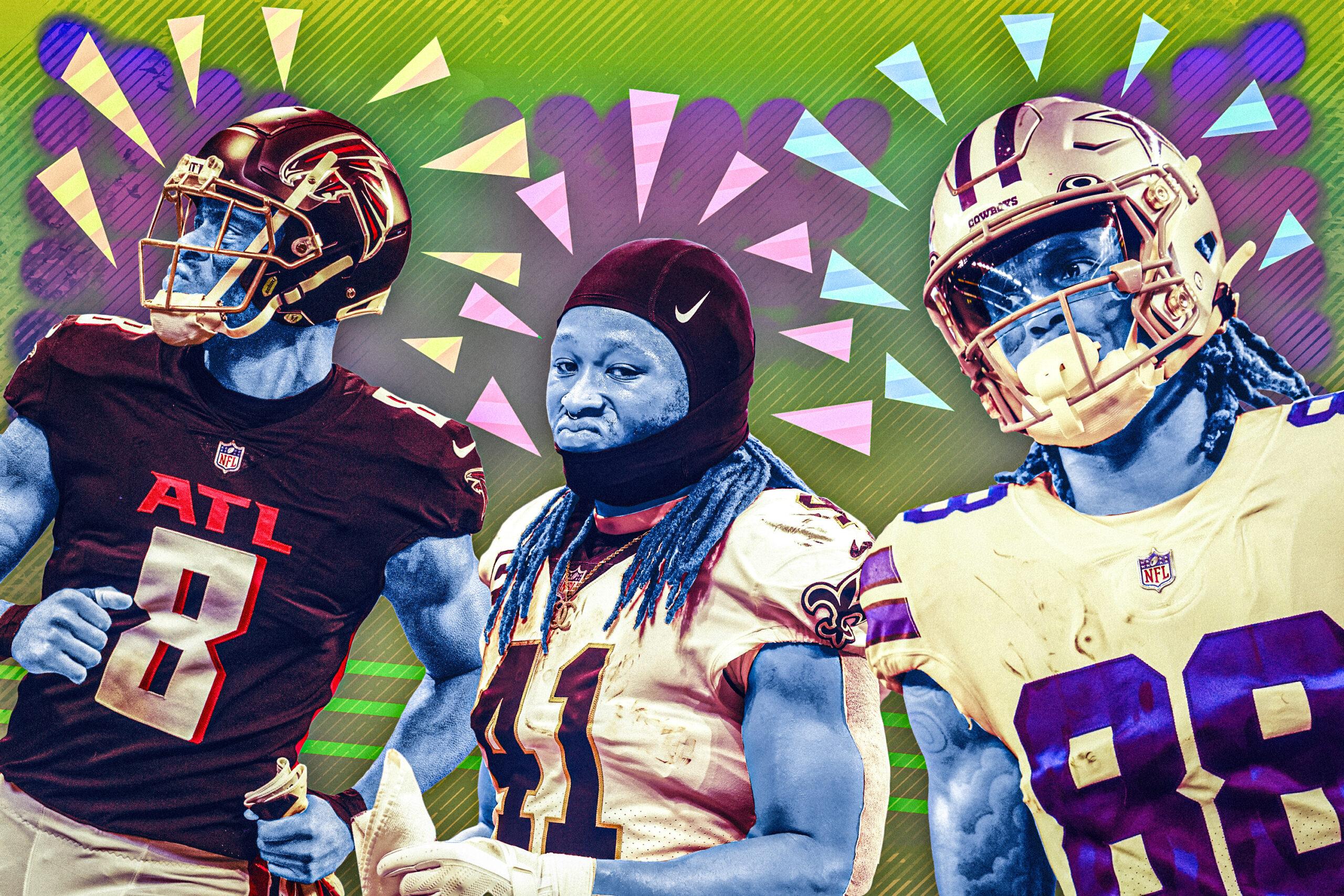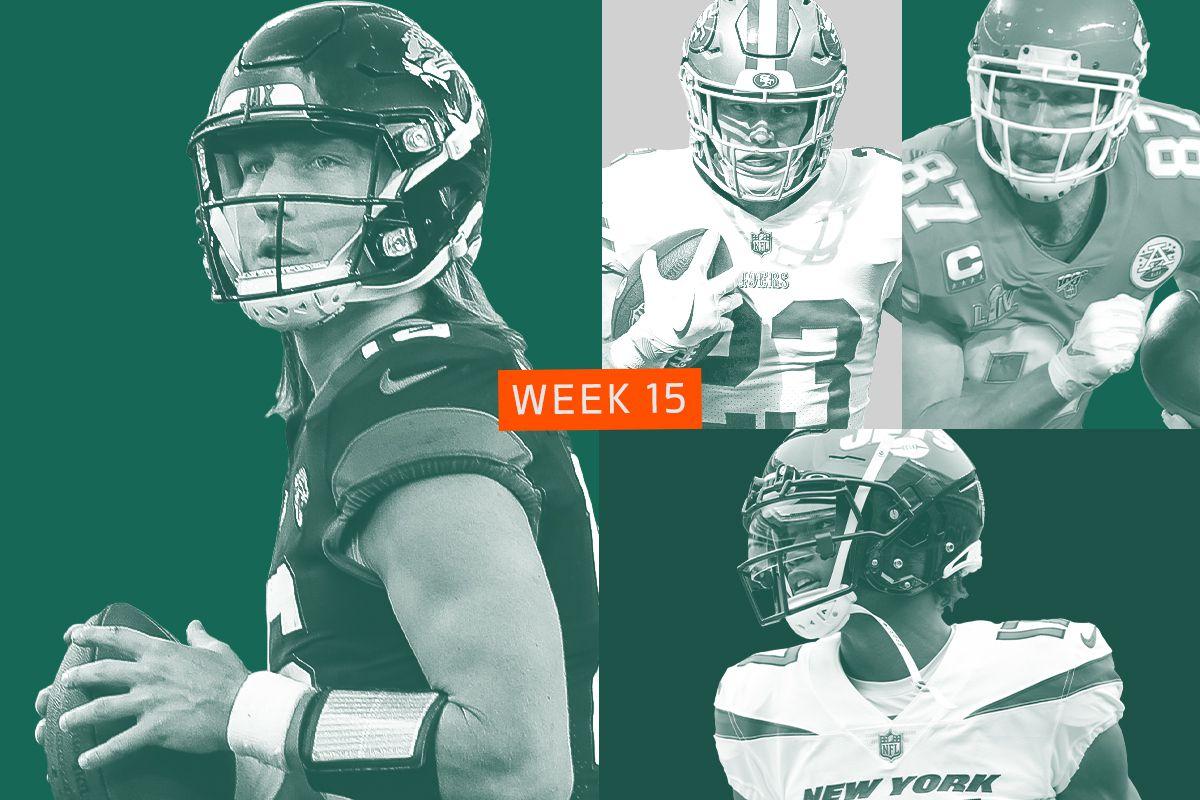Fantasy Football Week 1 Panic Index
From CeeDee Lamb to Kyle Pitts to Cam Akers, some players were just duds in Week 1. Which ones are worth truly worrying about?
The emotions fantasy managers experience during the NFL’s Week 1 action can be particularly powerful, as months of anticipation culminate with real, actual football—and real, actual fantasy scores. If you drafted one of this week’s fantasy superstars like Justin Jefferson, Cooper Kupp, Saquon Barkley, Michael Pittman Jr., or Davante Adams, you’re probably feeling pretty goddamn good about yourself (and your probably 1-0 fantasy team) right now. I can picture you strutting around your workplace, dazzling your colleagues with newfound charisma and conversational savoir faire. I’m guessing colors look more vibrant; food has never tasted so good. You have a visible aura.
But for those of you who used early-round picks on, say, CeeDee Lamb, Alvin Kamara, Kyle Pitts, Cam Akers, or Allen Robinson II—Week 1 was a massive letdown. Your team probably lost. You’re likely now plumbing the depths of your soul, searching for meaning among all this fantasy pain; the world feels cold; and your fantasy league text-chain is a dark and bottomless chasm of shame and degradation.
If you fall into that latter group, I’ve got some good news! It’s a long season; weird stuff happens in Week 1 every year; and sometimes even the best players have bad days. Yes, a few of this year’s projected high-end fantasy stars stumbled badly out the gate, but it’s not yet time to abandon all hope … at least not for all of them. After mixing the most important utilization metrics with a handful of contextual clues, here’s my Week 1 Fantasy Panic Index, using a 1.0 to 10.0 scale—with 10.0 being the fantasy equivalent of hyperventilating—for the players who underwhelmed over the weekend.
WR CeeDee Lamb and RB Ezekiel Elliott, Cowboys
Let’s start with Lamb, who was, perhaps regrettably, one of my favorite targets in drafts this year. Lamb’s ADP finished at no. 16 overall (WR6) this offseason thanks to a combination of talent and situation. It was easy to build a case for Lamb’s impending blastoff: With Amari Cooper and Cedrick Wilson Jr. gone, Lamb projected to be the clear-cut no. 1 pass catcher in the Cowboys’ high-volume, pass-heavy offense. Boasting excellent marks both from Pro Football Focus (he ranked eighth in the NFL in PFF’s receiving grade in 2021) and high-end efficiency as a pass catcher (tied for 12th in yards per route run last year), it was easy to imagine Lamb gobbling up 10 catches a game as the focal point in Dallas’s passing attack.
Week 1 was a bucket of cold water to all of that. Despite playing 67 of 69 snaps for the Cowboys, running 31 of his 45 routes from the slot, and collecting a team-high 11 targets, Lamb generated just two catches for 29 yards—good for a measly 3.9 half-PPR points. Discouragingly, he tallied a 51.0 receiving grade from PFF, which tied for 122nd at the receiver position. Cowboys executive vice president Stephen Jones didn’t gloss over Lamb’s flop, saying afterward that “CeeDee has got to improve and work his way into being the no. 1 receiver.”
Lamb’s tough outing exacerbates concern over his subpar performance down the stretch last year, when he averaged just 8.5 half-PPR points over the team’s final four games (making him the WR35 during the fantasy playoffs, weeks 14 to 17). It’s worth noting that Lamb’s bottom line could’ve looked a whole lot better in Week 1, as he did manage to get loose down the sideline late in the fourth quarter for what could’ve been a 74-yard touchdown—but he was badly overthrown by backup quarterback Cooper Rush. That probably serves as some foreshadowing for what’s to come following Dak Prescott’s injury.
With Prescott (who left the game in the fourth quarter) expected to miss anywhere from four to eight weeks following surgery on his thumb, concerns over Lamb’s individual performance are amplified by what I expect will be a dramatic downgrade in the Cowboys’ quarterback play over the next month or two. Lamb’s going to continue to get plenty of looks and it’s definitely not a bad thing that he saw 11 targets in Week 1, but the team’s overall ceiling has caved in. My hopes for Lamb finishing as a top-five receiver have greatly diminished.
CeeDee Lamb Panic Index: 8.0 out of 10.0
Now, on to Elliott. Things don’t seem quite as grim for the veteran running back, who managed 5.4 half-PPR points in the Week 1 letdown by rushing for 52 yards on 10 carries. Elliott, like the rest of the Cowboys offense, struggled to get things rolling on Sunday against a tough Tampa Bay front—but if there’s a silver lining, it’s that he won’t have to face off against the Buccaneers week in and week out. Tampa Bay gave up the third-fewest rushing yards to opponents last year and the fifth-fewest touchdowns. The sledding should get easier for Dallas’s patched-up offensive line.
Besides, volume always has been the name of the game with Elliott, and I don’t think the Cowboys will stray from their commitment to feeding him. In fact, with Prescott out, Dallas may lean even harder on its running game. He’s also likely to be utilized as a dump-off option for the inexperienced Rush, whose main job will be to put the ball in the hands of his playmakers. At the end of the day, I’m not terribly worried about Elliott, who Jerry Jones views as the engine of this team’s offense. But with no Prescott, his upside is capped: Dallas will see fewer trips to the red zone, will run fewer plays, and won’t have many leads to protect.
Ezekiel Elliott Panic Index: 5.5 out of 10.0
RB Alvin Kamara, Saints
It’s tough to know what to make of Kamara’s Week 1 flop. The typically hyper-efficient playmaker rushed nine times for 39 yards while adding three catches for 7 yards, finishing the day with just 6.1 half-PPR points. That’s an alarming performance for anyone relying on Kamara to be the backbone of their running back spot, of course, but there were a few extenuating factors that could’ve held his fantasy numbers down in this one.
For starters, Kamara left the game early with a rib injury (he’s expected to be fine), an issue that may have been bothering him earlier in the game. It’s also worth noting that the Saints offense really struggled as a whole to get anything going until the second half; New Orleans posted negative-2 net yards passing over the first two quarters and quickly found itself in a hole, pushing the team into comeback mode in the second half—a factor that no doubt limited Kamara’s usage on the ground. Additionally, Kamara ran a route on just 45 percent of the team’s dropbacks, well short of his normal route rate (he stayed in to block 11 times, besting his previous career high of seven). But that may have been a game-script-specific thing for a team that was down 26-10 early in the fourth quarter. With Jameis Winston looking to push the ball downfield and hopefully generate some explosive plays, the Saints might have asked Kamara to stay in to protect the quarterback a little more than usual. It also didn’t help that New Orleans ran just 57 plays, tied for its sixth-lowest total in the past three seasons. (The Saints have run fewer than 57 plays just 13 times since Kamara has been in the league.) To top it all off, Kamara also got vultured for a potential red zone touchdown by Taysom Hill.
On the other hand, Kamara graded out very poorly per Pro Football Focus, notching a 54.2 rating, 57th out of 72 eligible running backs. His low route participation may just be the new normal in an offense that has lots of talent at wide receiver. With Michael Thomas back in action, Jarvis Landry hoovering up targets, and Chris Olave an ascending pass catcher, Winston might just rely on his receivers more. He’s a YOLO-style passer who seems to prefer pushing the ball downfield more than checking it down to his running backs. The days of Kamara catching 80-plus passes may be in the rearview.
At this point, I’m chalking Kamara’s off game up to a combination of his injury and just the way the game unfolded. I’d temper expectations for the short term until we know he’s healthy, but I’d expect we see Kamara’s touch count go back up and his efficiency to return something closer to previously ludicrous levels. I remain cautiously optimistic.
Alvin Kamara Panic Index: 5.5 out of 10.0
TE Kyle Pitts, Falcons
Pitts’s Week 1 tumble was probably the most disappointing outcome of the weekend, at least for me personally. I admit, I had been hoping for a statement game from the über-talented, second-year tight end, but instead got a two-catch, 19-yard dud. The consensus TE3 in fantasy drafts prior to the season finished as this week’s TE36, totaling 2.9 half-PPR points. For some context on just how depressing that was, consider this:
But before giving up on Pitts’s big glow-up in 2022, it’s worth looking deeper than raw production and delving into how he was utilized by the Falcons on Sunday. On the negative side, he did stay in to block on seven snaps against the Saints, five more blocking snaps than he ever registered last year. But on the plus side, basically everything else looked great: Pitts played 63 of a possible 75 snaps (84 percent), running a route on 28 of 37 team dropbacks (76 percent) while matching Drake London for the team high with seven targets (good for a 21 percent target rate). He ran 74 percent of his routes while aligned in the slot or in-line. That’s the type of usage you’re looking for from a top tight end. He was running routes in the middle of the field, where he can create advantageous matchups.
Additionally, Pitts finished the game with 93 air yards (the total number of yards the football travels in the air on passes to a receiver), which ranked third among all TEs. His average depth of target was an impressive 11.9 yards. All this to say: The big plays will be coming.
Pitts is probably going to be more volatile than I would like. That’s what we saw last year, too, when he notched three or fewer catches in seven different games. With Marcus Mariota (and not Matt Ryan) under center, the Falcons’ passing game will be unpredictable. But I think explosion weeks are on Pitts’s horizon. And I’m still going to be plugging him into my lineups.
Kyle Pitts Panic Index: 4.0 out of 10.0
RB Cam Akers and WR Allen Robinson II, Rams
Akers served as a great and nearly immediate reminder that your fantasy team often looks a lot better on paper than it does in real life. Akers came into the Rams’ Thursday night opener as the consensus RB20 per ADP (the 43rd overall pick), a full 20 running back spots higher than RB40 Darrell Henderson Jr. (116th overall). Those two L.A. backs should probably have been flipped in fantasy drafts.
Though not listed on the team’s final injury report, Akers didn’t see the field until the second quarter and ultimately played just 12 snaps, finishing the opener with three rushes for zero yards and zero fantasy points. That came as an absolute shock to the fantasy community and was a far, far cry from the dominant workload he saw in the team’s playoff run last season, when Akers tallied touch counts of 18, 27, 14, and 16 in L.A.’s final four games. The lesson, I suppose, is that we should’ve paid more attention to the fact Akers averaged a measly 2.6 yards per carry on 67 totes in that stretch.
Akers may end up earning a bigger role going forward. Head coach Sean McVay said after the game that the team saw a few positives but needed “an increased level of urgency and accountability snap in and snap out” from the third-year back. All we can do now is wait. But barring injury, this looks like Henderson’s backfield to lose.
Cam Akers Panic Index: 9.0 out of 10.0
Allen Robinson II’s first game as a Ram went about as poorly as I could’ve imagined. The former Bears and Jaguars pass catcher registered as one of the Wind-Sprint champions of the week, collecting just two targets on 48 routes in the blowout loss to the Bills. Quarterback Matthew Stafford seemed to forget that Robinson was on the field, primarily force-feeding Cooper Kupp on play after play after play. As Rams beat writer Cameron DaSilva points out, the Bills did bracket Robinson with double coverage and lots of zone looks, but it was an inauspicious start for a veteran receiver who was coming off the board as the WR20 in fantasy drafts in August. He collected a 54.0 receiving grade from PFF, which tied for 110th out of 132 eligible receivers—which is not great, considering Robinson tied for 85th among qualifying receivers last year in the same metric while stumbling through his worst season as a pro.
Still, I’m not ready to abandon ship on Robinson quite yet. Both Stafford and McVay said after the game that they want and need to get Robinson more involved in the passing game, and it will be easier to do just that when L.A. isn’t playing against one of the most dominant pass-rushing teams in the NFL. Stafford had very little time to operate behind the Rams’ new-look offensive line and relied heavily on Kupp to survive. Robinson’s value remains as a red zone threat and no. 2 option, so I’ll reserve judgment for a few more weeks and give the Rams an opportunity to get him more involved.
Allen Robinson II Panic Index: 6.5 out of 10.0
WR Mike Williams, Chargers
Williams was a disappointing no-show in the Chargers’ opening-week win over the Raiders, collecting a measly two catches for 10 yards to finish with 2.0 half-PPR points. It was especially distressing that he did so with Keenan Allen on the sideline for more than half the game with an injury. But the underlying utilization metrics were encouraging nonetheless: Williams played 62 of the team’s 67 offensive snaps (93 percent) and ran routes on 31 of Justin Herbert’s 34 dropbacks (91 percent). His targets will come.
Much like Pitts, Williams is going to be a boom-or-bust fantasy option. That’s exactly what Williams was last year, too, when he finished as the WR15, notching six games with 18-plus fantasy points … and seven games with seven or fewer points. If you can handle the game-to-game volatility, I’m optimistic the explosive weeks will come. If you can’t take that kind of unpredictability, though, I’d suggest holding on and waiting for the next big game, and then trading him for someone a little more boring.
Mike Williams Panic Index: 3.0 out of 10.0


